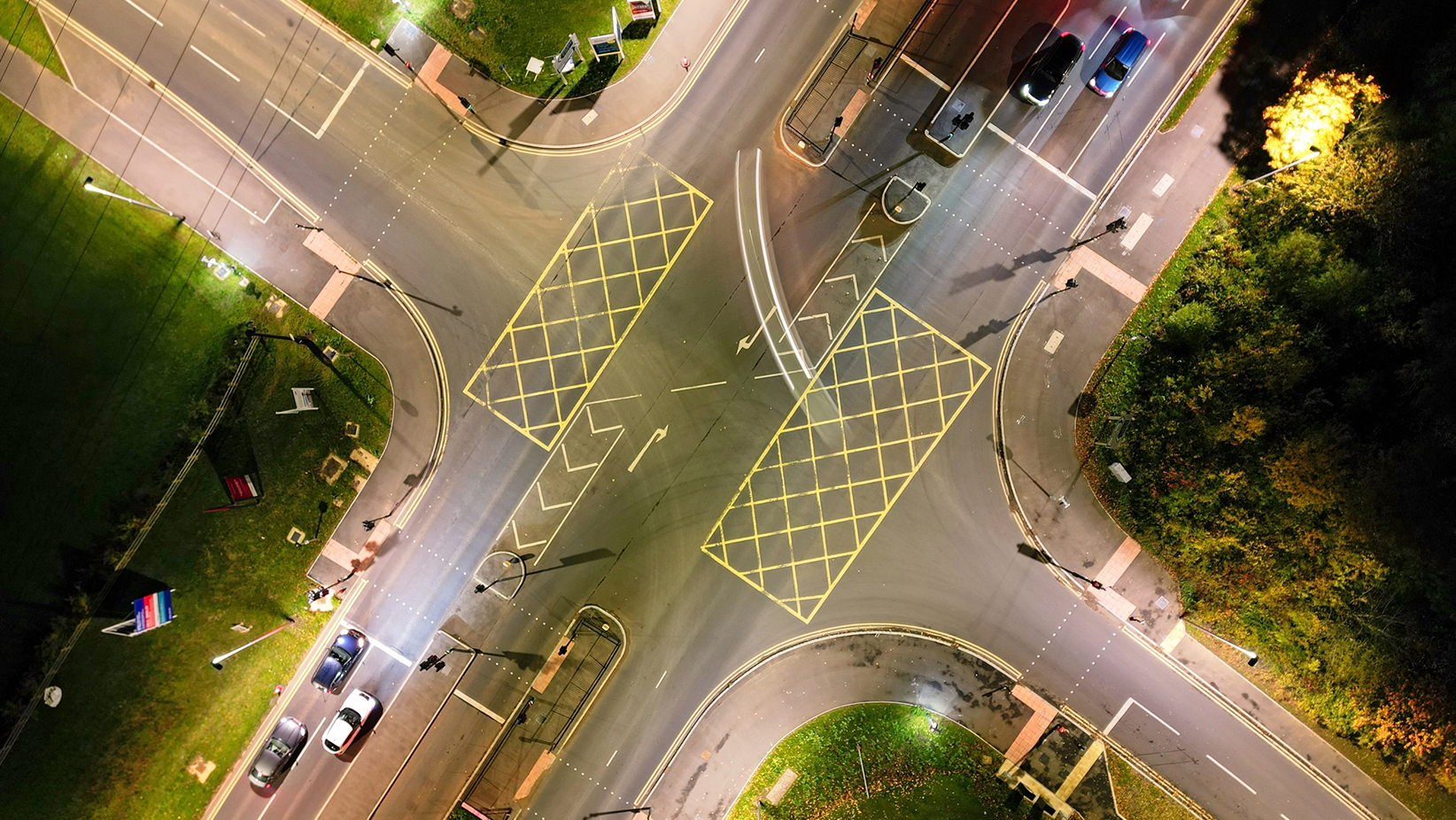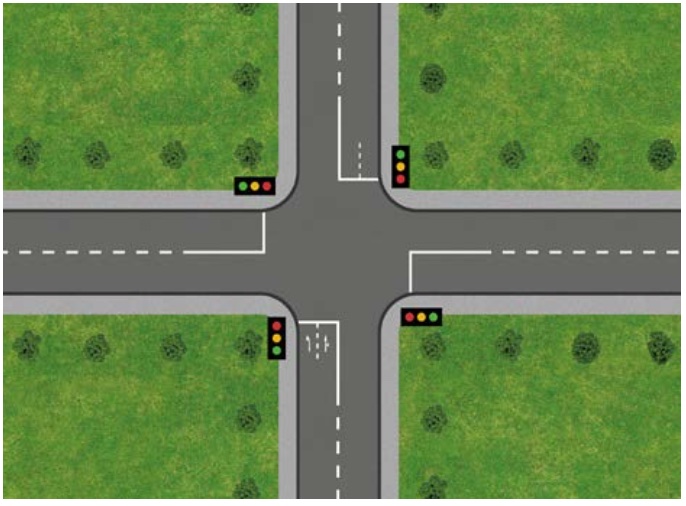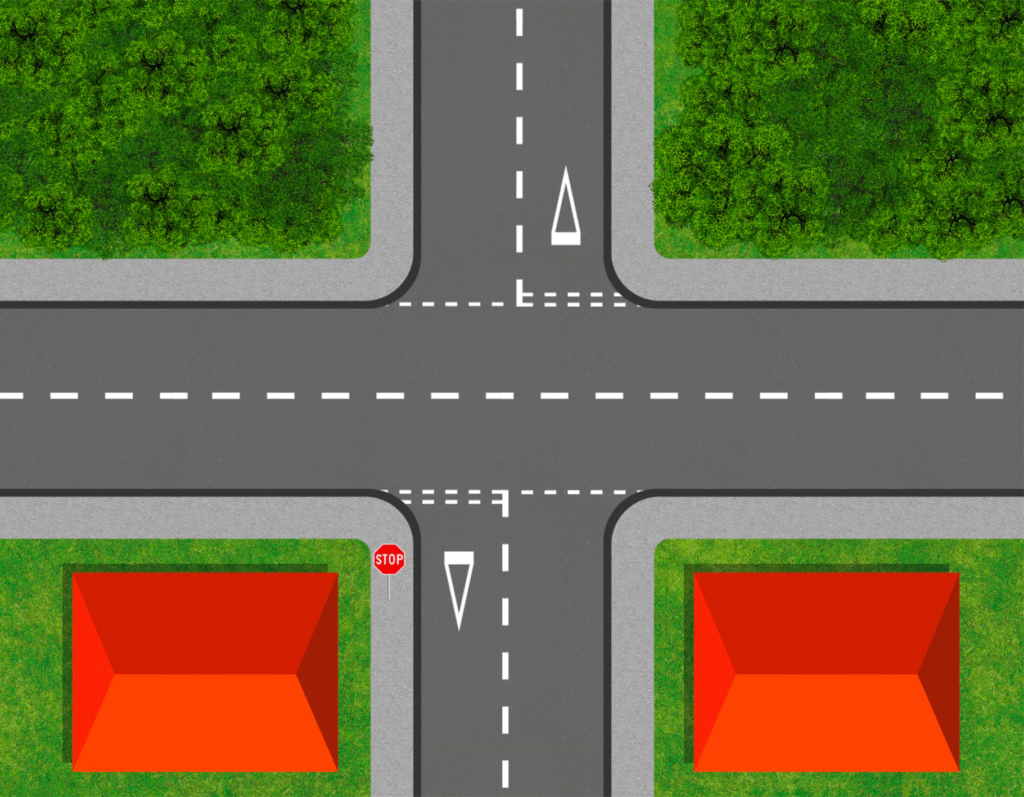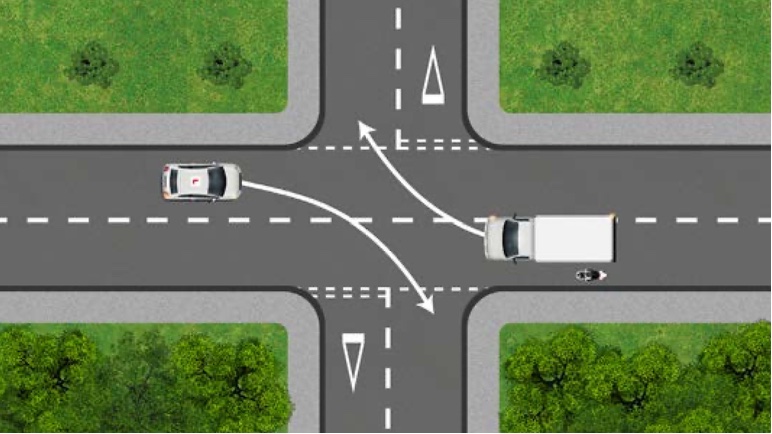Objectives: You should be able to identify uncontrolled and controlled crossroads. Use the MSPSL routine on the approach. You should be able to proceed ahead, to the left, and to the right from both major and minor roads, under control, whilst considering the safety of other road users.
What is a crossroad?
A crossroad is a place where two roads meet and cross; hence the name “crossroad”. As the roads join, drivers must decide which way to go, and traffic may cross paths as they change direction.
It is very important to understand crossroads to avoid a collision. Think of them as a point in the road where drivers need to choose a path and stick to it to keep moving safely. Without staying in the right lane, following signs and signalling correctly, other drivers and pedestrians may be confused, holding up the flow of traffic or causing an accident.
Never fear, though. We have explained everything you need to know about crossroads below, including how to approach and navigate them, so that you can drive across them confidently, no matter where you come across them.
- Difference between crossroads and junction
- What does a crossroads sign look like?
- Who has right of way at a crossroad?
- The four main types of crossroads
- The difference between the offside and nearside rule
- Dealing with crossroads from a major road
- Dealing with crossroads from a minor road
- Crossroads with a dual carriageway ahead
- Top test tips
Difference between crossroads and junction
A junction is a place where two or more roads meet. This broad definition includes all T-Junctions, Y-Junctions, roundabouts, slip roads, interchanges, as well as crossroads.
Crossroads are a specific type of junction where two roads cross, often in a + or X shape. So, in this way, every crossroad is a junction, but not every junction is a crossroad.
George Burrell, one of our driving instructors in Leeds, uses this to help his learners. “When we come to tackling the crossroads at Kirkstall Junction, pupils often get nervous. By then, we’ll have been through loads of junctions and I’ll have made sure they’re ready. I’ll say to them, ‘A crossroad is just a scary-looking junction. Just follow the rules I’ve taught you and you’ll be fine.’ And they always are.”
What does a crossroads sign look like?
The sign for a crossroads consists of a red triangle with a black pointed plus sign in the centre. Whenever you see it, you know that a crossroads is coming up. The Highway Code classifies it as a warning sign, and it will be placed ahead of the crossroad to give you time to slow down, check your mirrors, and prepare for traffic and pedestrians approaching from other directions.

Who has right of way at a crossroad?
This depends on the type of crossroad you are approaching. Stay alert and assess the type of crossroad as you approach it because the type will dictate who has right of way as well as how you should tackle it.
The four main types of crossroads
There are four types of crossroads that you may come across. Below, we have listed all four with pictures and descriptions, so you’ll be able to tell the difference while on your driving lesson.
Uncontrolled crossroads or unmarked crossroads
These are the most dangerous. Nobody has priority.
As you approach the uncontrolled/unmarked crossroad, slow down early to assess the situation and look out for approaching road users and pedestrians. Look in all directions, making eye contact with all approaching road users. Signal your intentions clearly to others and use your mirrors to continuously monitor the situation around you. Proceed only when you are certain it is safe to do so. Stay vigilant and be prepared to stop quickly. If in doubt, hold back.
Who has priority at an unmarked crossroads?
Absolutely no one. This is why these crossroads are the most dangerous, as other drivers may disagree on who has right of way, and this can result in an accident. Any pedestrian crossings have priority, and, as a general rule, drivers should give way to traffic already on the junction. Nevertheless, be careful, as other drivers may decide it is their right of way at any time and from any direction.
Controlled crossroad
These will either have a give way line or occasionally a stop line. It is important to come to a complete stop and apply your handbrake if necessary before you observe at a Stop Junction. You should also be extra careful when emerging from one, as visibility is usually restricted. Clearly signal to show other road users the direction you are planning to go in, and only proceed when it is safe.
Traffic light-controlled crossroads
On the approach, plan how to move into the appropriate lane for the direction you want to go. Try to move into that lane as early as possible. If you have to stop at the traffic lights, check your door mirror(s) before you move off. Sometimes motorcyclists and cyclists can catch you up. When you are changing direction, it’s always a good idea to look in all directions first, just in case someone has jumped the lights or the lights are not working.
You’re approaching a crossroad; what should you do if the traffic lights have failed?
If the traffic lights at a crossroad are not working, then this junction must be treated as an uncontrolled crossroad. Approach slowly and with caution, continuously monitor and observe the situation, clearly signal your intentions to others, and only proceed when you are certain it is safe to do so.
Crossroads with a yellow box junction
Do not enter a yellow box junction if your exit is not clear, unless you want to turn right but you are prevented from turning right by oncoming traffic. Look ahead early and try to work out if the vehicle in front of you is going to not only clear the box junction, but also leave enough room for you to go behind without sitting in the box junction.
Dealing with crossroads from a major road
When you are on a major road, ensure that you glance right and left for any vehicles pulling out in front of you.
If you have to turn right and another car wants to turn right at the same time, try to follow the offside to offside rule explained below. If the roads are small or narrow, then you may have to do the nearside to nearside rule; again this is explained a little bit later.
When it comes to crossing traffic on 30mph roads, remember the rule: if you can walk across, drive across. If you’re unsure about turning right, then take a look at turning right from a major to minor road.
Dealing with crossroads from a minor road
The routine you should use on the approach is MSPSL again. Everything remains the same as a normal emerging at a T-Junction situation except for the ‘Look’.
Where to look at crossroads: The minimum observations required at any crossroad are right, left, ahead, and then right before you pull out. If your visibility is restricted, you may need to repeat those observations.
The Difference Between the Offside and Nearside Rule
Offside to offside turning explained
This is the safest way of turning right at the same time as another road user. If the crossroads are wide enough, you can usually pass the other vehicle wanting to turn right and turn behind each other.
Nearside to nearside turning explained
This is more dangerous because you are turning before each other. You would usually only do this if you can see down the road you are turning into fully. In the event that you can’t see fully into the minor road, then it’s best to make eye contact with the other road user and try to work out who is going to turn first. If in doubt, hold back.
Crossroads with a dual carriageway ahead
These can be challenging, as you cross over into fast-moving traffic. Therefore, they are worth extra consideration.
As with any other crossroads, approach slowly and with caution to give you time to assess the situation around you and mentally map out the path you need to take. Check your mirrors and make sure you are prepared to stop if necessary. If you are crossing onto a dual carriageway, there will often be a central reservation (a barrier or strip of land) with a gap in it to allow traffic to pass through. At this gap, you may pause to wait for traffic to pass and then join or cross the dual carriageway when it is clear to do so. Signal to let other traffic know your intentions early, and always be aware of fast-moving traffic on the dual carriageway. Allow extra space for this before joining or crossing to ensure that other road users do not need to swerve or slow down to avoid you.
Though it might be tempting to rush, especially if you are feeling anxious, make sure to stay calm and take your time. Cross or join the dual carriageway steadily and increase your speed gradually if you are joining a dual carriageway. If you have clearly signalled and are keeping an eye on the road users/pedestrians around you, you will have the time and space to do this, and others will understand your intentions.
Top test tips
Taking your driving lessons in London means you will potentially come across busy crossroads on your test. When you approach from the minor road, be sure to keep your observations going on the approach: right, left, ahead, and right.
Be careful and watch out for cars turning from a major road too early: this is called a corner cut. If you see anyone corner-cutting, make sure you stop before the give way line to avoid a collision.
Final thoughts on mastering crossroads driving
Crossroads are an important part of the UK’s road network, allowing multiple roads to intersect without taking up much space. They can seem intimidating, especially when you are taking your driving lessons in Manchester or another city, and there is a lot of traffic; hopefully, though, you have seen from the above article that they look worse than they are. By approaching with caution, carefully observing signs as well as other road users and pedestrians, and signalling clearly, all crossroads can be easily navigated. Simply follow the rules outlined above, and you will be able to face them with confidence.

Written by Anthony Johnson
Grade A - 51/51
ORDIT Registered Trainer















